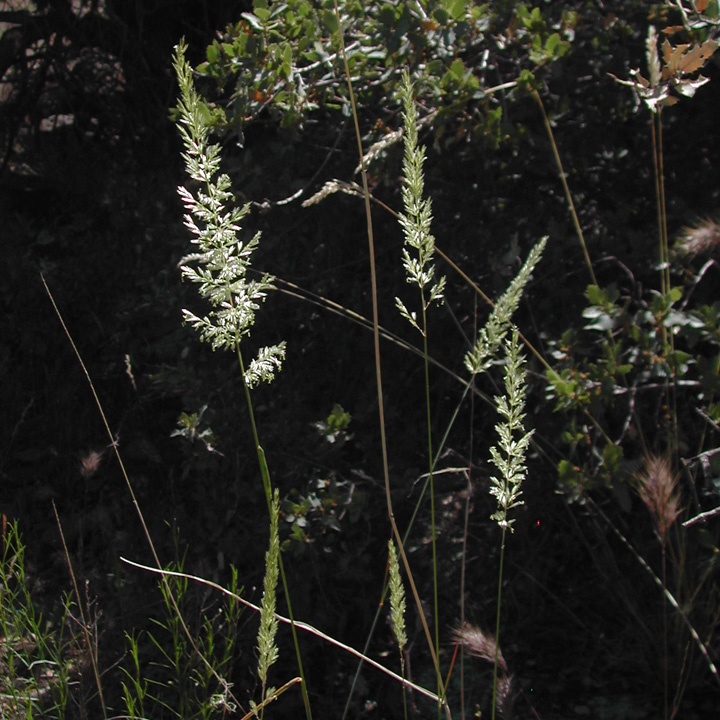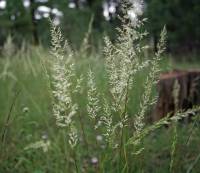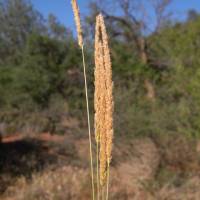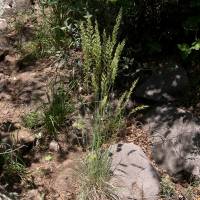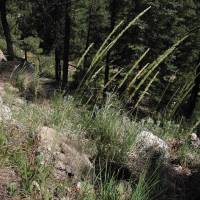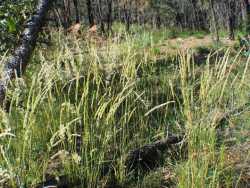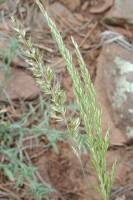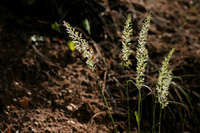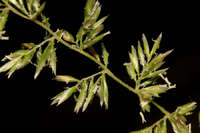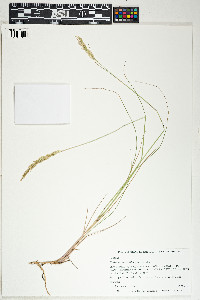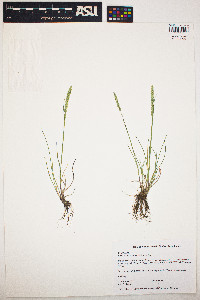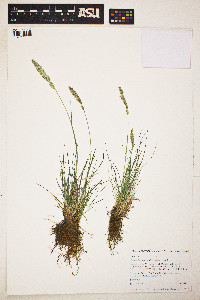|
Family: Poaceae
prairie Junegrass
[ Koeleria albescens DC., moreKoeleria gracilis Pers., nom. superfl., Koeleria nitida Ten., nom. rej., Koeleria yukonensis Hultén] |
Plants cespitose, sometimes loosely so. Culms 20-85(130)
cm, mostly glabrous, pubescent below the panicles and near the nodes. Leaves primarily
basal; sheaths pubescent or glabrous, breaking off with age or,
if disintegrating into fibers, the fibers straight; ligules 0.5-2
mm; blades 2-20 cm long, 0.5-3(4.5) mm wide, flat, involute when
dry, minutely scabrous, occasionally glabrous or densely pubescent, margins
of the basal blades glabrous or with hairs averaging less than 1 mm near
the base. Panicles 4-27 cm long, 0.5-2 cm wide, interrupted at the
base, otherwise dense; branches finely pubescent to villous. Spikelets 2.5-6.5
mm, obovate to obelliptic, with 2(3) florets; rachillas pubescent. Glumes 2.5-5
mm, ovate, membranous, green, scabrous except for the ciliate keels, apices
acute; calluses pubescent; lemmas 2.5-6.5 mm, membranous,
shining, usually glabrous, sometimes scabrous, particularly on the keels,
usually green when young, sometimes purple-tinged, stramineous at maturity,
acuminate, midveins prolonged as an awn to 1 mm; paleas shorter
than the lemmas; anthers 1-2.5(3) mm. 2n = 14, 28.
Koeleria macrantha is widely distributed in temperate regions of North America and Eurasia. In North America, it grows in semi-arid to mesic conditions, on dry prairies or in grassy woods, generally in sandy soil, from sea level to 3900 m. It differs from Sphenopholis intermedia, with which it is frequently confused, in its less open panicles, and in having spikelets that disarticulate above the glumes.
The species is treated here as a polymorphic, polyploid complex. North American plants have sometimes been treated as a separate species, Koeleria nitida Nutt., but no morphological characters for distinguishing them from Eurasian members of the complex are known (Greuter 1968). Some plants from Oregon and Washington have densely pubescent culms, and high-elevation populations from western North America often are densely cespitose, with very short culms and purple leaves and inflorescences, but both variants appear to intergrade with more typical plants.
FNA 2003, Gould 1980 Common Name: prairie Junegrass Duration: Perennial Nativity: Native Lifeform: Graminoid General: Perennial bunchgrass, 25-70 cm tall; mostly glabrous, pubescent with short-grayish hairs below the panicles and near the nodes. Vegetative: Blades mostly basal, 1-4 mm wide, upper surface of the blades prominently ribbed; sheath rounded on back or somewhat keeled, with rough, firm, stiff hairs; ligule 1-2 mm long, truncate to irregularly toothed-ciliate, whitish, thin and translucent, often w Inflorescence: Panicle narrow, contracted, appears like a dense aggregation of spikelets; spikelets laterally compressed, 4-5 mm long, with 2 or 3 florets; disarticulation above the glumes; lower glume lance-ovate; upper glume obovate, shorter than lowest lemma, with scarious margins; lemma barely nerved, awnless, with broad translucent margins; palea entirely translucent, as long as lemma. Ecology: Found on rocky slopes, woodlands and open forests, pine woods from 4,000-9,000 ft (1219-2743 m); flowers May-Sept. Distribution: Western, central, and midwestern US, through adjacent CAN to AK. Notes: Distinguished by being a small bunchgrass, with prominent raised veins (ribbing) on the upper surface of the blades, and having a small, white membranous ligule often with a torn "divot" in the middle when the blade is pulled back. There may be some value for Junegrass to suppress invasive annuals. Often treated as K. pyramidata or K. cristata, the latest Flora of North America treatment (as well as Flora Neomexicana, 2012) is considering North American material to be K. macrantha. Appears similar to Sphenolepis obtusata, but disarticulation is below the glumes on that species (i.e. glumes detatch along with the seeds, while in K. macrantha the glumes remain attached to the plant when the seeds fall off.) Ethnobotany: Seeds used as a grain in bread and porridge; used ceremonially in the Sun Dance; straw added to adobe and bundles used as brooms. Etymology: Koeleria is named for German botanist L. Koeler (1765-1807), while macrantha is Latin for large-flowered. Synonyms: Koeleria macrantha, K. cristata, K. cristata var. longifolia, K. cristata var. pinetorum, K. gracilis, K. nitida, K. pyramidata, K. yukonensis, Aira macrantha Editor: SBuckley 2010, AHazelton 2015 |

